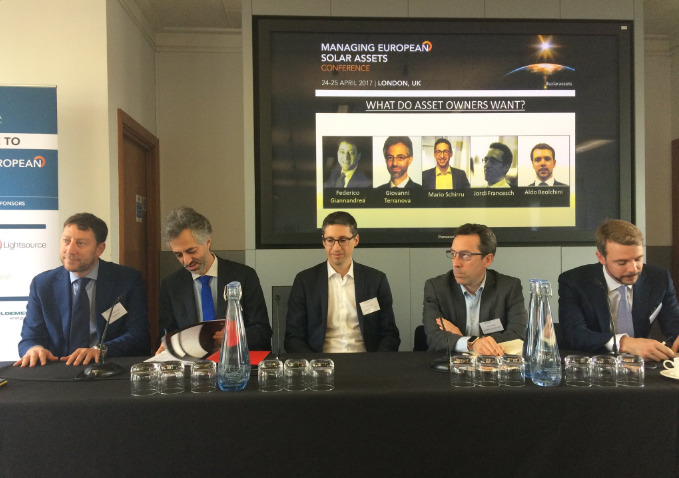
L-R: Federico Giannandrea, Foresight; Giovanni Terranova, Bluefield; Mario Schirru, Capital Stage; Jordi Francesch, Glennmont Partners; Aldo Beolchini, Next Energy Capital.
The biggest challenges facing asset owners are the requirements of adapting to subsidy free solar following rapid reductions in support for the technology around the world, according to a panel of large scale investors.
Speaking at Solar Media’s Managing European Solar Assets conference in London, representatives from some of the largest market players claimed that investors are struggling to come to terms with 'the new market reality' following reductions in incentive schemes implemented by government’s throughout Europe.
Mario Schiurru, investment director at Capital Stage, said: “The biggest challenge I see is to adapt to a new market environment in which you don't have tariffs anymore. You have investors who are used to fixed returns and have to now understand that this is not going to continue in this way.”
He added that while some fixed, long-term returns are still available through power purchase agreements with utilities or private off-takers, a level of investor education was now needed to ensure the market knows profits can still be made that are “comparable to what could be gained from the whole market in the past.”
This was echoed by Federico Giannandrea, partner at Foresight and head of the company in Italy, who said it is finding a mismatch between raising funds and deploying them on new projects.
“I think going forward, the lapse in support for businesses from governments will lead to grid parity competition and what we see as a challenge today is that we need to convince some power purchase companies like utilities and traders to give us the possibility of building new assets and buying electricity from us,” he said.
Jordi Francesch, head of asset management at Glennmont Partners, agreed and said that the challenge now was adapting to a landscape in which solar was becoming a “normal mainstream technology” that must compete on equal terms with traditional generation.
“For players like us its a game-changer in terms of changing your mindset from moving from fixed returns which are very predictable…to a model where there is high variability on the revenue which means there is more risk,” he said.
“I think it will change the landscape for who has the appetite for risk to invest in these kinds of assets.”
“A climate of relaxation”
However Aldo Beolchini, chief financial officer and managing partner at Next Energy Capital, claimed asset owners were not paying enough attention to the performance of their existing portfolios.
“In this new era of solar without subsidy, without help, the technology needs to do better. In my mind its been the same for ten years, the only improvements have been marginal so the technology and the [rate of improvement] is appalling and needs to do much better,” he said.
Beolchini continued by challenging O&M providers to do better, claiming there was an absence of significant optimisations and improvements to offer more than “a couple of thousand pounds off per megawatt”.
He went on to say that the responsibility also sits with asset owners, who as an industry have fallen into a “climate of relaxation on the existing assets”.
“Just compare the theoretical yield of an asset on any single day and what comes out of the monitoring. The issue is that the entire industry relaxed itself on a banking case that was serving the debts, paying the dividends and everybody was happy but sub-optimal, it's just a waste. It takes a lot of time and effort to chase the theoretical limits but it has to be done,” he added.

Taking place in London between 24-25 April, Solar Media's Managing European Solar Assets conference brings together over 40 asset owners to discuss best practice of getting the best out of a portfolio, as well as future developments for the sector. Tickets for the second day are still available and can be found here.

